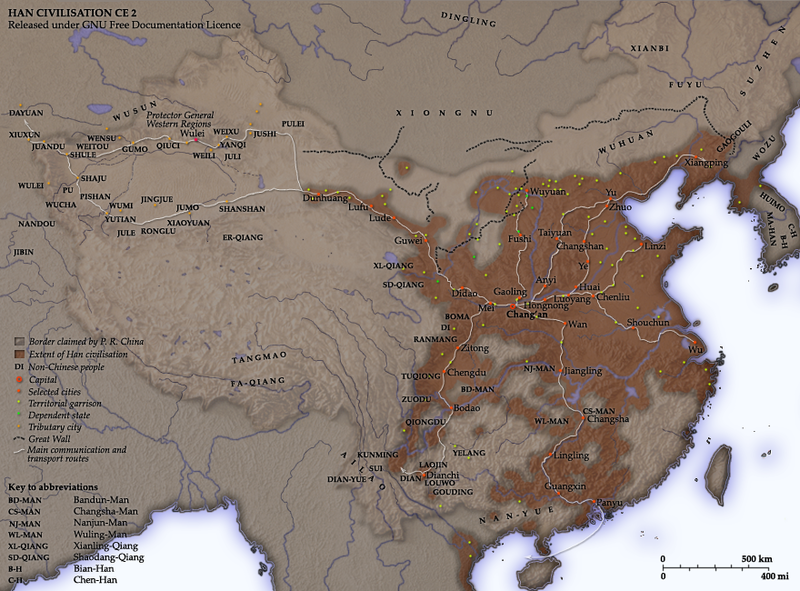Berkas:Han Civilisation.png

Ukuran pratayang ini: 800 × 591 piksel. Resolusi lainnya: 320 × 236 piksel | 640 × 473 piksel | 880 × 650 piksel.
Ukuran asli (880 × 650 piksel, ukuran berkas: 1 MB, tipe MIME: image/png)
Riwayat berkas
Klik pada tanggal/waktu untuk melihat berkas ini pada saat tersebut.
| Tanggal/Waktu | Miniatur | Dimensi | Pengguna | Komentar | |
|---|---|---|---|---|---|
| terkini | 2 November 2006 08.56 |  | 880 × 650 (1 MB) | Shizhao | {{Information| |Description= __NOTOC__ == Notes == Created and copyright (2006) by Yeu Ninje. Released under the GNU FDL. This map shows the world as was known to en:Han Dynasty [[:en:Ch |
Penggunaan berkas
Halaman berikut menggunakan berkas ini:
Penggunaan berkas global
Wiki lain berikut menggunakan berkas ini:
- Penggunaan pada an.wikipedia.org
- Penggunaan pada ar.wikipedia.org
- Penggunaan pada azb.wikipedia.org
- Penggunaan pada beta.wikiversity.org
- Penggunaan pada en.wikipedia.org
- Xiongnu
- User talk:Yeu Ninje
- History of Yunnan
- User:Yeu Ninje/Maps
- Portal:China
- Wikipedia:Featured picture candidates/delist/2006
- Wikipedia:Picture of the day/June 2006
- User talk:La goutte de pluie/archive 5
- Wikipedia:Featured picture candidates/Han foreign relations 2 CE
- Wikipedia:Wikipedia Signpost/2006-03-13/Features and admins
- Wikipedia:Featured picture candidates/March-2006
- Wikipedia:Picture of the day/June 13, 2006
- Wikipedia:POTD/June 13, 2006
- Wikipedia:POTD column/June 13, 2006
- Wikipedia:POTD row/June 13, 2006
- Portal:Geography/Featured picture/2006, week 25
- Wikipedia:Featured picture candidates/Han Civilisation.png
- Portal:China/Selected article and pictures
- Portal:Maps/Selected picture
- Portal:China/Selected picture/2006
- Portal:China/Selected picture/2006/December
- Portal:Geography/Featured picture archive/2006
- User talk:Yu Ninjie~enwiki/Archive 2006
- Portal:Maps/Selected picture/19
- Chao Cuo
- Wikipedia:Featured picture candidates/delist/2009
- History of the Han dynasty
- User talk:Jimbo Wales/Archive 10
- Wikipedia:Featured picture candidates/delist/File:Han Civilisation.png
- Wikipedia:Wikipedia Signpost/2006-03-13/SPV
- User:JPxG/SP 2006-2010
- Wikipedia:Wikipedia Signpost/Single/2006-03-13
- Penggunaan pada en.wiktionary.org
- Penggunaan pada fr.wikipedia.org
- Penggunaan pada he.wikipedia.org
- Penggunaan pada hi.wikipedia.org
- Penggunaan pada it.wikipedia.org
- Penggunaan pada ja.wikipedia.org
- Penggunaan pada kk.wikipedia.org
- Penggunaan pada la.wikipedia.org
Lihat lebih banyak penggunaan global dari berkas ini.


